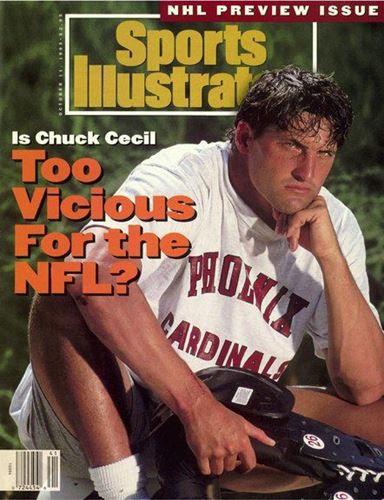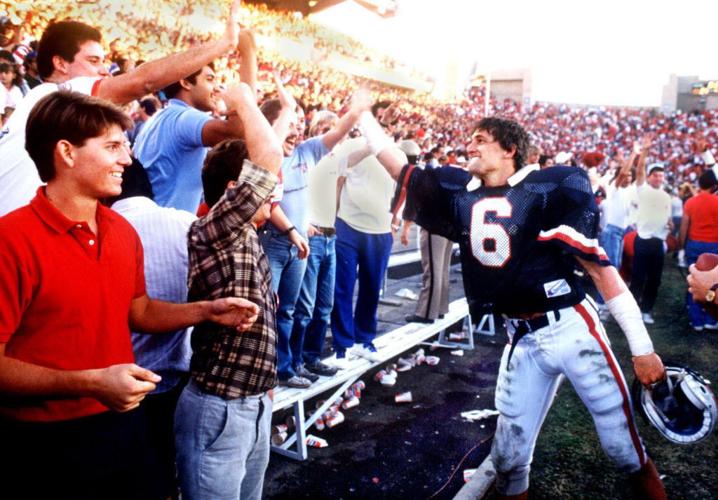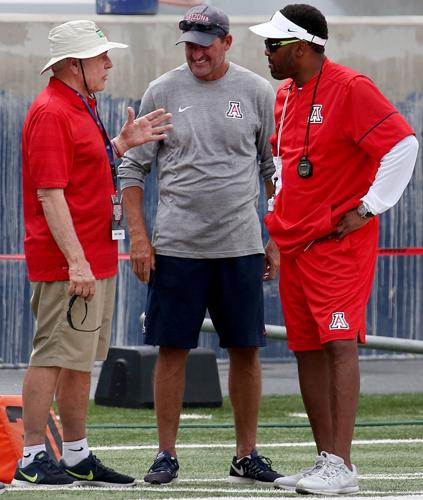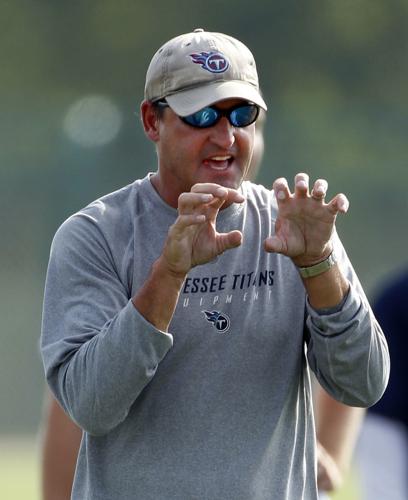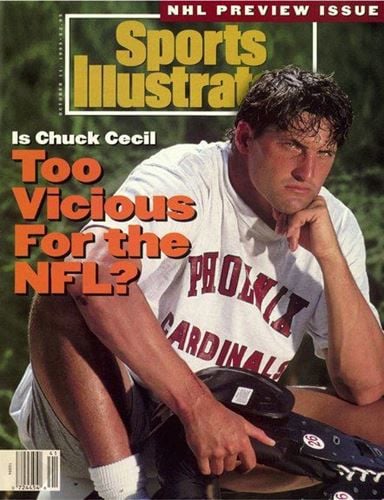In 1993, my husband, Chuck Cecil, signed a million-dollar, free-agent contract with the Phoenix Cardinals after playing five seasons with the Green Bay Packers.
Deemed “The Heat-Seeking Missile” during his All-American career at the University of Arizona, Chuck reluctantly agreed to an interview with Sports Illustrated’s Rick Telander.
This was no small feat for the Cardinals’ public relations team, as Chuck was well known for loathing notoriety, self-promotion and the media. He still says, “The film doesn’t have sound.” Meaning: Show me, don’t tell me who you are on or off of the field.
On that fall day in Tempe, Chuck spent less than five minutes after the Cardinals practice posing for the picture that would become the famed SI cover: “Is Chuck Cecil Too Vicious For the NFL?”
Telander would describe Chuck’s play as both terrifying and thrilling to watch. At 185 pounds, Chuck was known for a blatant disregard for his body and the body of anyone whom dared to cross his side of the field. While head coaches like the Dallas Cowboys’ Jimmy Johnson heaped praise on him, saying “that’s the kind of play I want to see,” Chuck drew ire from the NFL and would ultimately be fined for his hit on Washington Redskins tight end Ron Middleton. Bill Polian, the league’s vice president for football development in 1993 and ’94, fined Chuck $30,000, which at the time was the largest non-suspension fine ever imposed on a player. Polian’s son, Dennis, is now Kevin Sumlin’s associate athletic director for football at UA. Chuck now jokes with Dennis about the fine, but at the time, he would say that it was worth it — the hit fired up the Cardinals’ defense, and they stopped a critical fourth-quarter drive by Washington. The Cardinals won 17-10, their first victory at RFK Stadium in 15 years.
That kind of hard-hitting play is what commentators said landed Chuck in the Pro Bowl and ultimately labeled him one of the most feared defensive backs in the NFL. He gave hope to small defensive backs across the country.
On the eve of the 25th anniversary of his SI cover, I sat down with Chuck over chili and root beer to talk to about it. The conversation was like pulling teeth, even for me. Chuck still hates talking about himself.

Chuck Cecil celebrates with fans after the Wildcats defeated ASU in 1986, thanks to Cecil’s 106-yard interception return.
Playing the game today
I began, “Mental and physical intimidation was a large part of the way you played.” His green eyes looked up at me. “But with the onslaught of rule changes impacting defenders, do you think that you could play at the pro level in today’s game?”
“Reeeaaally? You’re going to go right there?” He stirred his chili. “There’s no doubt that I couldn’t play the game the way I did. I grew up playing through people. We hit and tackled with every fiber of our bodies, and that included our helmets. Today, we have new rules in place for player safety, and that’s critical at any level, but it doesn’t mean you can’t play ferociously; you just have to have different strategies, tactics and techniques.”
He set down his spoon. “I am a firm believer that it’s not the size of the dog in the fight, but the size of the fight in the dog,” he said. “I had a lot of fight in me at 22 years old.”
Chuck had an uncanny ability to increase his speed before blowing up an offensive player. It is something that goes against human instinct to slow down rather than speed up prior to a collision, and it was always unsettling to watch.

Chuck Cecil, chatting here with former UA coach Dick Tomey, left, and current coach Kevin Sumlin, will be behind the microphone on the CW for seven Sugar Skulls home games.
Concussions and brain trauma in the sport
Experts in traumatic brain injury would agree that Chuck’s style of play has led some players to be diagnosed with post-concussion syndrome. PCS was something that I felt might be inevitable, that the fate that our friend and former NFL Pro Bowler Junior Seau incurred would catch up to him. Neuroscientists found chronic traumatic encephalopathy — the degenerative disease linked to repeated blows to the head — in Seau’s brain after he committed suicide.
“I’ve had good friends, good men in football who have struggled with the affects from PCS,” Chuck said as he cleared the table. “For how I played the game and the amount of concussions that I have had, I think I am an anomaly to be both physically and mentally healthy. It’s honestly such a gift.”
Part of Chuck’s good health can be linked to coaching. Doctors have told us that he thrives in a game-planning and play-calling environment. It is a high-pressure game of football chess, and he’s very good at chess. Chuck is constantly running mind games with his opponents, which has helped him to stay mentally fit.
“Physically I have aches and pains like anyone who played sports their whole life, but nothing to complain about, as I can still play golf,” he said.
After both his mom and dad died, Chuck stepped up his physical health. He hasn’t had alcohol in years, and is committed to working out four to five times a week.

Chuck Cecil calls to the Titans’ defense during their 2009 game against the Colts. He coached in Tennessee from 2001-10.
Becoming a coach in the NFL
“After you retired from playing in the NFL, what made you want to go in to coaching?” I asked while loading the dishwasher.
He chuckled. “You said you wouldn’t have a baby until I got a real job.”
In the late-’90s, Chuck played on the Celebrity Players Golf Tour along with his pals Charles Barkley, Michael Jordan and John Elway. We weren’t exactly in their pay grade.
“I wanted to take my time before I went back to the game,” he said. “I loved it and respected my coaches and what they did for me. I needed to be really ready. I can remember talking to other players who had become coaches too early after playing — and they still wanted to play. I never wanted to be that guy standing on the sidelines longing to put on pads. I’m not sure that feeling ever goes away, but I got to a place where I was mature enough to positively make the transition and add value as a coach.”
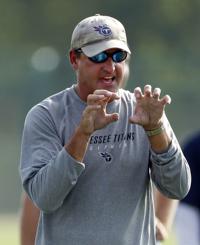
Cecil was a defensive coach for the Titans from 2001-10. He also coached with the St. Louis/Los Angeles Rams.
The pros vs. college
As we leashed up our dogs for our evening walk, I asked: “What would you say the main differences are between coaching in the pros vs. at the college level?”
He picked up the poop bags and headed out the door.
“First and foremost there are constraints with the amount of time you can spend with the players,” he said. “In the NFL, it’s a player’s full-time job to grind as much as humanly possible, while in the NCAA our guys are splitting time between getting their educations, growing up and playing the game.”
He pondered as we watched the Tucson sunset.
“And, we have different responsibilities to the players in college,” he said. “They are much more impressionable. They are 18-to-21-year-olds. It’s important to positively shape these young men and instill good character alongside techniques and Xs and Os. In the pros, the guys are still young, but it’s about teaching them to outplay their opponent — all day, every day. Many people believe that just because you coach at the pro level you can coach at the college level, but the game-planning, strategy and play-calling is very different. A lot of the college game is predicated on the field and boundaries, where in the NFL it is predicated more on formation and personnel. It’s absolutely awesome to be able to pull from both experiences to get the most out of the guys on the field.”

Chuck Cecil returned to the his alma mater after a long stay in the NFL as an assistant for the Titans (2001-10) and Rams (2012-16).
Coming back home
“So, what would you say brought you back to Arizona?”
Chuck pulled the comforter down on our bed.
“Being back home with Arizona football has always been my dream. You know that,” he said. “I wanted to give back to the school and community that poured so much into my life. The first time that possibility became a reality was when I was the defensive coordinator at the Tennessee Titans. (Athletic director) Greg Byrne flew to Nashville when he was looking to hire a head coach after Mike Stoops. We had an informal interview about the job. Although I knew in the back of my mind he was going to hire someone like coach (Rich) Rodriguez, I appreciated his time and learned a lot from the process. That day lit a fire in me that there was a real possibility of coming back to Tucson.”
Chuck headed to coach the St. Louis Rams, but I remember him talking on and off to coach Rodriguez about Arizona. It wasn’t until we went to Bruce Arians’ golf tournament in Georgia that Rich asked Chuck to come back.
“It was an opening that I couldn’t pass up,” he said. “Just the right place at the right time.”

From left, Charli, Chuck and Carrie Cecil smile on the field before a UA game. Chuck Cecil is a senior defensive analyst.
What’s next?
I asked my last question before turning out the lights. It was a question we don’t really talk about as a family. We learn to live in the moment and not guess about what the future holds.
With the departure of Rodriguez last year and the addition of Sumlin, I would be lying to say there hasn’t been uncertainty. Thankfully, coach Sumlin was gracious enough to keep Chuck on staff as a senior defensive analyst.
“I feel extremely fortunate to have the opportunity to work and learn from Kevin every day,” he said. “ You have to know your place in this business. Be a good lieutenant. Do everything you can to help your boss and be a positive influence on the players and coaches.”
But I know my better half — and in Chuck’s heart, he is a coach. NCAA rules do not allow him to coach the players as an anaylst. His job is more to help the coaches and review opponents. I know he misses the position room and his guys.
“So, what do you think is next for us?” I asked.
“Beating UCLA,” he said with absolute seriousness. “We need to focus on each day, each week, help our team win games and be grateful for what we have.”
It sounds like a line from Crash Davis in “Bull Durham,” yes. But this is just who he is, and why I married him.
In 25 years since his SI cover, I can honestly say he’s gotten better with age. He still opens my car door when we go out for ice cream the same way he did on our first date. But he’s grown into a wiser man, a patient husband — as I can be a handful — and a selfless father.
“Good night, sunshine,” he said, giving me a kiss.
I sighed with gratitude knowing my whole world is wrapped up in this life with this man and that no matter what the next 25 years holds for us, I trust that we’re in it together. Jeremiah 29:11 — I’ll show up and take care of you as I promised and bring you back home. I know what I’m doing. I have it all planned out — plans to take care of you, not abandon you, plans to give you the future you hope for” — applies to our future and our lives.
Trust the plan.


